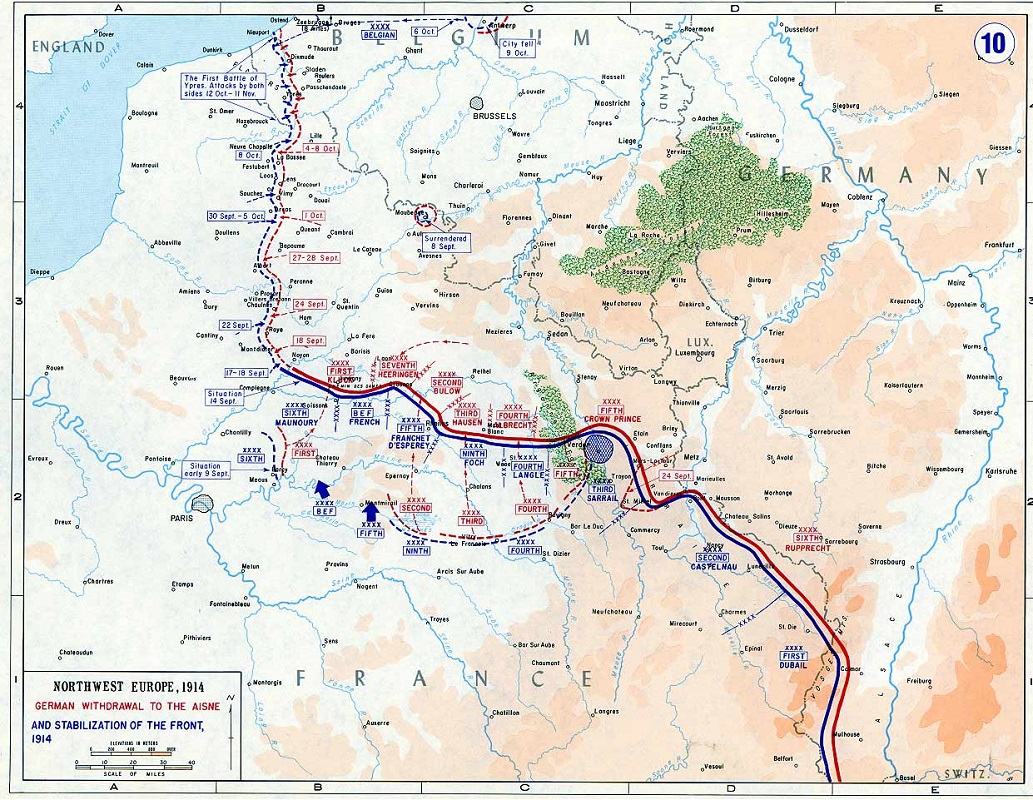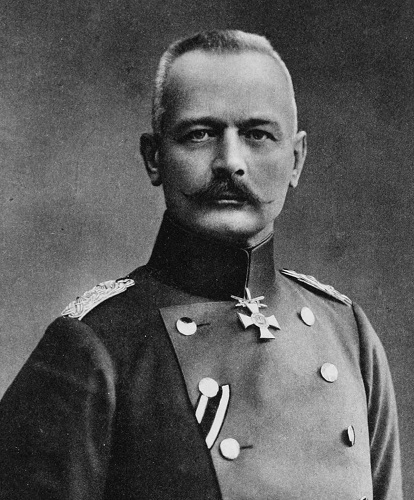● ● ●
For
clarity, German units are rendered in italics.
Though the Battle of the Marne was
an Allied victory, the German Army was not decisively
defeated. The retreat of its right wing to the Aisne River,
ordered on 8 September, was carried out in good order and by
13 December the Germans had taken up an entrenched position
on that line. The Allies’ followup was slow, due both to
caution and the troops’ fatigue, and their attacks on 15-16
September were repulsed.
But beyond the Aisne position lay
open country and the opposing commanders, General Joseph
Joffre and General of Infantry Erich von Falkenhayn, who had
by now replaced Moltke as Chief of the OHL, both sought
victory by turning the enemy’s open western flank. To that
end, both sides began transferring troops from east to west.
The French had begun to do so as early as 2 September, in
line with Joffre’s inflexible determination to resume the
offensive at the earliest possible moment. The Germans soon
followed suit, taking troops from their left flank and also
from Belgium to constitute an attacking force on their
right. Thus between mid-September and mid-October there
ensued a series of encounter battles as each side sought
without success to envelop the other’s open flank. These
seesaw battles—so-called Race to the Sea—extended the front west, then north, until
the Channel coast was reached in the vicinity of Nieuport.
Here and a little farther south around the town of Ypres the
Germans were to make a final bid for the decisive victory
that had eluded them on the Marne.

The "Race to the Sea"
(Department of History, USMA West Point)
It will be remembered that early in
the campaign the Belgian Army had withdrawn into the
fortified camp of Antwerp, from which position it
constituted a threat to the rear of the advancing German
right wing. The Belgians, indeed, had conducted several
sorties out of their fortifications in an attempt to support
the British and French fighting on the main front. Some on
the Allied side, Winston Churchill prominent among them,
hoped that that the Belgian Army would prove able to hold
Antwerp indefinitely, placing such pressure on the Germans
as to compel their withdraw to the east. The First Lord of
the Admiralty made the defense of Antwerp his personal
crusade, extemporizing a brigade of Royal Marines for
dispatch to the city and agitating for further British
reinforcements. These were sent and Churchill himself spent
considerable time in Antwerp: a diversion from his principal
duties as civilian head of the Royal Navy that attracted
much criticism.
But it soon became clear that the
Antwerp position was untenable. Alarmed by the Belgian
sorties, the Germans reinforced their besieging troops and
opened a heavy bombardment on 28 September. Things quickly
went from bad to worse for the defenders and on 10 October
the Belgian Commander-in-Chief, King Albert, ordered his
army to quit Antwerp and retire west along the Channel
coast. With the Belgians went the British defenders: the
Royal Marine Brigade and the Royal Naval Division—the latter
made up of reservists excess to the RN’s requirements,
organized as infantry. Along the way they linked up with
further British troops: the 7th Division and the 3rd Cavalry
Division, which had been landed west of Antwerp at Zeebrugge.
The remaining garrison capitulated, 30,000 mostly Belgian
soldiers being taken prisoner. But the bulk of the Belgian
and British troops survived to reach the line of the Yser
River, just east of Nieuport, on 14 October. Meanwhile the
BEF was completing its transfer from the Allied center to
Belgium, this to position it closer to its main base, Le
Harve on the Channel coast.

General of Infantry Erich
von Falkenhayn, Moltke's successor as Chief of the OHL (Bundesarchiv)
For his part Falkenhayn remained
intent on a war-winning offensive. His intention was to
deliver an “annihilating blow,” crushing the Allied left
flank and driving along the Channel coast to capture Dunkirk
and Calais. This, he calculated, would knock out the British
Army and compel the French to ask for terms. The German
attack was to be two-pronged: Fourth Army (Duke
Albrecht of Württemberg; fifteen
infantry divisions) would strike across the Yser
while Sixth Army (Crown Prince
Rupprecht of Bavaria; eleven infantry divisions, six
cavalry divisions) would capture the town of Ypres and
strike west. Both German armies had been reconstituted and
reinforced after their transfer from the left wing. The
reinforcements for Fourth Army included four newly
raised reserve corps (eight divisions) whose troops,
sketchily trained and poorly equipped, were young volunteers
who’d rallied to the colors in August. They were to suffer
heavily in the ensuing battle.
The overall commander on the Allied
side was General Ferdinand Foch, whom Joffre had appointed
commandant le groupe des Armées
du Nord (commander of the group of northern
armies) on 4 October. Though he had no formal authority over
the British and Belgian forces in Flanders, Foch was able to
obtain their cooperation and it was he who coordinated the
defense. The Allied order of battle embodied the Belgian
Army (six infantry divisions, a French infantry division,
six battalions of French marines) and the French Eighth Army
(twelve infantry divisions, eight cavalry divisions) holding a line south from
the Channel coast. The BEF (seven infantry divisions, three
cavalry divisions) held Ypres area, its left flank linking
up with French forces
south of Ypres.

General Ferdinand Foch,
who coordinated the defense of Ypres and the Channel coast
(Musée
de l'Armée)
Belgian Flanders is a mostly flat
plain enclosed by a system of canals linking the region’s
major towns. On the Channel coast the ground is at sea
level, fringed by sand dunes. Farther inland the terrain is
mostly meadow cut by canals, dykes, drainage ditches, and
roads laid on built-up causeways. A line of low hills
stretches east from the town of Cassel to Mount Kemmel. From
there, a low ridge stretches to the northeast, past the town
of Ypres then curving north and northwest to the plain. In
1914 the area south of the La Bassée Canal around Lens and
Béthune was a coal-mining district studded with slag heaps,
pit-heads and miners' cottages. North of the canal, the city
of Lille and its environs constituted a manufacturing area.
Otherwise the land was given over to agriculture,
crisscrossed by hedgerows, roads and narrow tracks. Because
the water table in Flanders is so close to the surface, the
ground in spring and summer often becomes an impassable
morass. Overall, Flanders was a far-from-ideal setting for
offensive military operations. Lack of observation limited
the effectiveness of artillery, while the many
obstructions—canals, streams, villages, slag heaps,
etc.—hampered advancing infantry and made cavalry operations
virtually impossible.
The First Battle of Flanders ran
from ran from 18 October to 30 November 1914. For both
sides, it was a sanguinary introduction to the realities of
warfare between mass armies armed with modern weapons. And
for the British in particular, the names associated with
Flanders—Ypres, Passchendaele, Gheluvelt, Polygon Wood—would
be inscribed with letters of scarlet in the regimental
histories of the BEF.